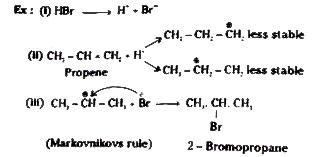Addition HBr to propene yields 2-bromopropane, while in the presence of benzoyl peroxide, the same reaction yields 1-bromopropane. Explain and give mechanism.Solution in Telugu
HBr directly add to the propane, according to Markovnikov's rule. While in the presence of benzoyl peroxide HBr to propene according to anti Markovnikov rule.
Markovnik's rule: This rules states that when an unsymmetrical reagent adds to a double bond. the +Vve part of the adding reagent attaches itself to a carbon of the double bond so as to give the more table carbocation as an intermediate.

Anti markovnikov's rule (or) Kharasch effect: In presence of peroxide, addition of hydrogen halides to as unsymmetrical alkenes takes places in such a way that hydrogen atom becomes attached to the carbon atom having the fewer number of hydrogen atoms.
CH3−CH=CH2+HBrPropene(C6H5CO)2O2−−−−−−−−−→CH3−CH2−CH2Br1-Bromopropane
Topper's Solved these Questions
- ORGANIC CHEMISTRYBOOK - VGS PUBLICATION-BRILLIANTCHAPTER - ORGANIC CHEMISTRYEXERCISE - Short Answer Questions
17 Videos
- MOST IMPORTANT QUESTIONSBOOK - VGS PUBLICATION-BRILLIANTCHAPTER - MOST IMPORTANT QUESTIONSEXERCISE - ORGANIC CHEMISTRY (LONG ANSWER TYPE QUESTIONS)
11 Videos
- STATES OF MATTER : GASES AND LIQUIDSBOOK - VGS PUBLICATION-BRILLIANTCHAPTER - STATES OF MATTER : GASES AND LIQUIDSEXERCISE - ADDITIONAL QUESTION & ANSWERS
10 Videos
Similar Questions
Complete the following reactions and name the products A,B and C.
CaC2H2O−−→Ahot metal tube−−−−−−−−→BAlCl3+CH3Cl−−−−−−−−→C
View SolutionExplain Wurtz - Fitting reaction
View SolutionA balloon is filled with hydrogen at room temperature. It will burst if pressure exceeds 0.2 bar, If at 1 bar pressure the gas occupies 2.27 L volume, upto what volume can the balloon be expanded?
View SolutionAssertion : Propene reacts with HBr in presence of benzoyl peroxide to yield 1- bromopropane. Reason : In presence of peroxide , the addition of HBr to propane follows ionic mechanism.
View SolutionAddition of HBr to propene yields 2-bromopropane, while in the presence of benzoyl peroxide, the same reaction yields 1-bromopropane. Explain and give mechanism.
View SolutionAssertion : Propene reacts with HBr in presence of benzoyl peroxide to yield 1− bromopropane.
Reason : In presence of peroxide , the addition of HBr to propane follows ionic mechanism.
View Solutionप्रोपीन पर HBr के संकलन से 2- ब्रोमोप्रोपेन बनता है, जबकि बेंजॉयल पराक्साइड की उपस्थिति में यह अभिक्रिया 1 -ब्रोमोप्रोपीन देती है । क्रियाविधि की सहायता से इसका कारण स्पष्ट कीजिए ।
View SolutionAddition of HBr to propene yields 2-bromopropane, while in the presence of benzoyl peroxide, the same reaction yields 1-bromopropane. Explain and give mechanism.
View Solutionप्रोपीन पर HBr के संकलन से 2-ब्रोमोप्रोपेन बनता है जबकि बेंजॉयल पेरोक्साइड की उपस्थिति में यह अभिक्रिया 1-ब्रोमोप्रोपेन देती है। क्रियाविधि की सहायता से इसका कारण स्पष्ट कीजिए।
View SolutionAssertion: Addition of HBr to propene yields 2-bromopropane but in presence of a peroxide it yields 1-bromopropane. Reason: When reaction is carried out in the presence of a peroxide it follows free radical mechanism, 2^(@) free radical is more stable than 1^(@) free radical.
View SolutionHBr synthesizes with propane and gives 2-bromo prosen. 1-bromopropane in the presence of the same benzoyl peroxide
View SolutionAssertion : Propene reacts with HBr in the presence of peroxides to give 1-bromopropane. Reason : Alkenes react with HBr in the presence of peroxides according to anti Markovnikov's rule.
View Solutionप्रक्कथन : प्रोपीन बेन्जोइल परॉक्साइड की उपस्थिति में HBr के साथ अभिक्रिया करके 2-ब्रोमोप्रोपेन उत्पादित करता है।
कारण : परॉक्साइड की उपस्थिति में प्रोपीन पर HBr का योग आयनिक क्रियाविधि का पालन करता है।
View SolutionAddition of HBr to propene yields 2-bromopropane, while in the presence of benzoyl peroxide, the same reaction yields 1-bromopropane. Explain and give mechanism.
View SolutionAssertion: Addition of HBr to propene yields 2-bromopropane but in presence of a peroxide it yields 1-bromopropane.
Reason: When reaction is carried out in the presence of a peroxide it follows free radical mechanism, 2∘ free radical is more stable than 1∘ free radical.
View Solution
